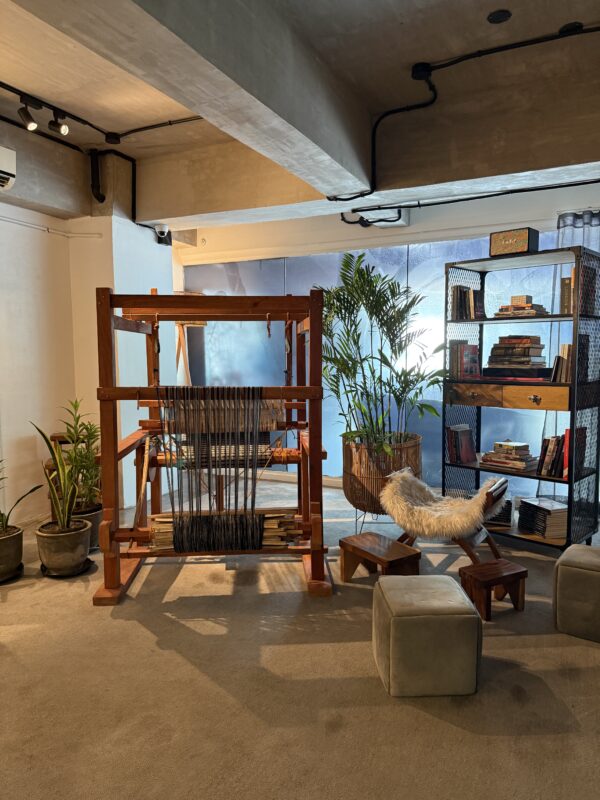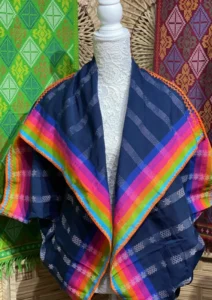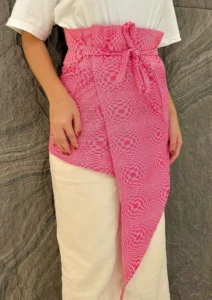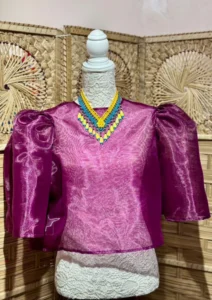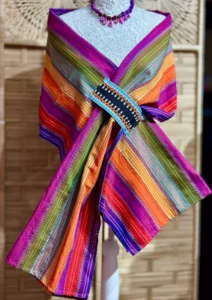Philippine weaving is an ancient traditional art that has persisted through time. While other forms of traditional arts are highly threatened such as chants, tattooing, as well as regional cuisines, a revival that has been never seen since the end of World War II is observed in textile production and appreciation at present. This can be seen in the growth of stores dedicated to locally handmade textiles as well as online shops.
Philippine textiles are a rich repository of traditional Filipino patterns, symbols, and cultural wealth (Pastor-Roces, 1991), and flowers are a universal language. When floral motifs are expressed on a weave, it transcends cultural boundaries and can communicate not only what flowers the artists are exposed to, but, more importantly, it becomes a crucial element in the formation of their worldviews and identities. A flower pattern can stand alone or can be combined with others (such as animal or abstract patterns) to suggest a more sophisticated artwork.
The penchant for using floral motifs may also not only be a personal choice of the weaver, but a predisposed attraction that has been running across generations in his or her family. Some of these patterns are largely associated with works of National Living Treasure Awardees of the Philippines as well, as in the case of the Inubon a Sabong (String of Flowers) with Magdalena Gamayo. This paper explores some floral patterns expressed in four weaving groups in the Philippines: Ilocanos and Tingguians, Yakans, and Blaans. It also discusses the status of Philippine weaves as well as presents a framework in the assessment of handwoven textiles.
The Ilocanos and Tingguians
The Ilocanos and the Tingguians are two separate groups in the north that share the same language. Though the Tingguians are classified as indigenous people, the ilocanos are not. The former would largely be concentrated in the Cordillera highlands, while the latter would be in the lowlands of the Ilocos Region (Region 1). Given their proximity with one another, their weaving history is almost intertwined if not shared. Patterns and themes expressed have similarities as well as differences, but the traditional execution contrasts: the Tingguians are more adept in the use of backstrap looms, and the Ilocanos, the upright looms.
Northern Philippine weave has been observed to be the most prolific in producing floral patterns in their textiles. Some of these are still in production today and may even have undergone changes, while others can only be appreciated as relics of the past with only few surviving samples left.
In a town called Paoay in the province of Ilocos Norte, packets of weaving communities thrive, each having their own specialization: the Barangay Nalasin, for example, is proficient in the sinukitan technique (supplementary weft), while the areas surrounding Paoay Lake are homes to weavers who are skilled in the kundiman technique (multi-heddle). The town also saw the largest volume of traded inabel during the Galleon Trade (Respicio, 1999), and this could be accounted for by its high number of weavers and the fact that the port of Currimao, an intermediary galleon trade port, was then still part of the town (Guerrero, 2021). It has also been reported that the inabel of the north was the most heavily exported Philippine textile during that period (Valmonte 1988).
Plants and flowers may be the most popular motifs in sinukitan inabel, as well as the most prolific in terms of variations. The sinan-rositas (rosette-like) has been observed to vary from weaver to weaver. Finer details appear to have been lost in modern renditions and the pattern has become significantly larger, allowing easier production. The sinan-bulbulala (cross-section of a flower-like) and the sinan-rositas are thought to be the oldest representations of a flower from the said weaving community (Guerrero, 2021).
Sabong ti Parya (Flower of the Bittergourd) and Lopis (Cottonball)
The interesting Sabong ti Parya pattern is sought-after for its beauty and rarity. The persisting version indicates rococo elements with its highly ornate curving tendrils, foliage, and framing. The pattern is an heirloom pattern of one family, the Ralleca-Cabugon, and has been passed on for four generations of weavers in the town of Paoay. The significance of the pattern is equally telling as the parya (Tagalog: ampalaya), plays a crucial role in the Ilocano cuisine and is consumed in various ways such as in pinakbet (Ilocano vegetable stew). Its blanched leaves are also eaten as a local salad.
Blanket with the heirloom sinan-sabong ti parya (bittergourd flower-like)
The same weaving family is also known to produce another pattern that is currently not made by others: the sinan-lopis (cottonball-like). The first photo below is the lopis pattern made by the Ralleca-Cabugon family, while the second one is from a 1960s cotton blanket bearing the same pattern but rendered differently. The lopis is also held dearly among weavers and textile collectors alike as it illustrates how a weaving material, cotton in this case, is held dearly by the Ilocanos and Tingguians considering that the Ilocos region used to be the largest producer of cotton in the Philippines until all the cotton plantations were decimated in World War II (Respicio, 1999).
Figure 2: Older versions of the Ilocano/Tingguian lopis (cottonball)
Rositas (Rosettes)
The sinan-rositas has been observed to vary from weaver to weaver, and it appears to be a highly favored motif in inabel weaving. It is an abstract representation of a generic flower usually appearing in blankets, bed covers and pillowcases. The oldest specimens of a rositas recovered during the study are from the early 1920s and are laid out in the rigodon orientation where two patterns occur alternatingly and are equally rendered in two alternating colors. A rigodon could be set in a wide permutation of two patterns of the same motif made differently, or two separate patterns of two differing motifs (Guerrero, 2021).
The rositas can also be combined with other patterns and motifs forming a more complex design field, such as in the cases of the pabo (Peacock/ Turkey) and the aguila (Double-headed Eagle). The pabo and aguila are two enduring patterns that are believed to have been conceived during the Spanish period. The pabo is considered as the most intricate patterns to come out of the sinukitan inabel weaving category as it uses as much as 168 design sticks to complete the assymetrical pattern. The aguila, on the other hand, has a deep history as it is the local reinterpretation of an Augustinian symbol (it also appearing in the coat of arms of the Habsburg), the order that established the town of Paoay. In both, the rositas is laid out as part of a garland frame encasing the birds. The aguila and specially the pabo have long been considered as status symbols and were only afforded by the members of the alta sociedad back in the day.
Figure 3 Ilocano rositas (Rosettes) and rositas garland surrounding a pabo (Turkey).
The influences of the structure of the rositas also extend to non-floral patterns. Features are instantly noticed to have been derived from the rositas in portraying stylized crabs (kappi), corns (mais-mais), rice cakes (baduya, a traditional rice cake in Paoay prepared during all Saint’s Day), and the 20-centavo American period coin (binting pattern). To the untrained eye and those who are new in the textile world, the four patterns mentioned above can easily be mistaken as versions of the rositas, although clearly they depict something else. The need to maintain the patterns’ identities and original names are important to keep so that they are never lost.
While the ornate, traditional rositas versions are still being produced, albeit in small scales, simpler ones are now developing and are the ones heavily saturating the market.
Bulbulala (Cross-section of a Flower)
Another enduring motif is the bulbulala, of which the oldest specimen examined is an early 20th century handspun, vegetable-dyed cotton blanket. Marketed inaccurately today as the “orange slices” pattern, the bulbulala is possibly the simplest, most basic floral motif from the north. Observed to have been a largely fossilized pattern, the bulbulala has changed little and offers minimal permutations in its depiction; it contrasts massively with the circumstances of the rositas. It is characterized by eight curve-edge petals pivoting around a circle and is likewise commonly laid out in two alternating colors. The Ilocanos and the Tingguians differ from the weaving traditions in Mindanao by their minimal use of colors and ability to embrace wide empty spaces in between patterns. Mindanao weavers have the proclivity to use a wide array of colors and are noted to be afflicted with horror-vacui, the fear of spaces (Guerrero, 2021).
A modern version of bulbulala (cross-section of a flower)
A recent version of bulbulala surfaced in Ilocos Norte, and instead of having solid petals, the pattern is assembled in a pointillist manner that is achieved by using more interlocking warp threads that consequently break down the inserted supplementary weft threads. Other than this version, the bulbulala appears the same as it was, possibly, when it was first conceived.
Inubon a Sabong (String of Flowers)
The most famous floral pattern to come out of Ilocano inabel weaving is the inubon a sabong¸ which has become almost synonymous with National Living Treasure (Manlilikha ng Bayan) Magdalena Gamayo of Pinili, Ilocos Norte. The pattern is complicated to achieve as it uses a combination of supplementary warps and supplementary wefts crossing each other creating a plaid-like arrangement. The technique of weaving that is utilized in creating the inubon a sabong is called impalagto, which falls under the multi-heddle (four pedaled loom) category of weaving. The pattern can also be achieved using the sinukitan weaving technique, but it would take a highly skilled weaver to be able to precisely replicate it.
While Gamayo does not claim to have created the pattern herself and admits having copied it from a piece she saw when she was young, the pattern, over time, has widely been recognized and institutionalized to be her masterpiece. A sample of which is on display at the National Museum of the Philippines. The inubon a sabong is said to have been inspired by a quintessential Ilocano child’s favorite past-time: connecting strands of flowers of the ornamental santan plant (Ixora coccinea) from one end to another to make a floral string and is usually worn as a bracelet.




